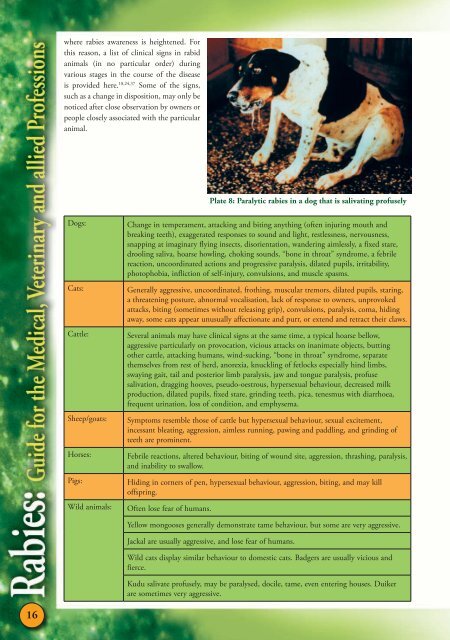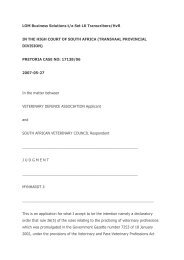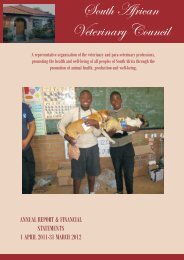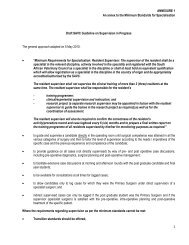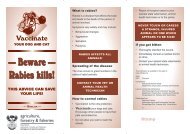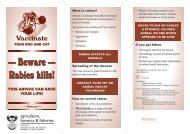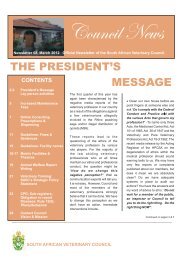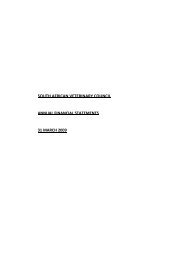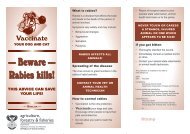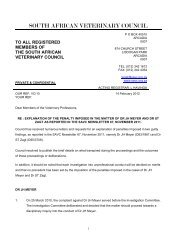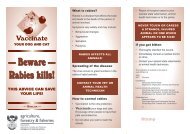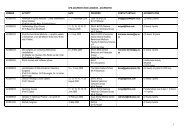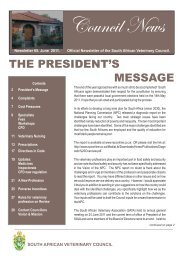Rabies Guide 2010.pdf - the South African Veterinary Council
Rabies Guide 2010.pdf - the South African Veterinary Council
Rabies Guide 2010.pdf - the South African Veterinary Council
You also want an ePaper? Increase the reach of your titles
YUMPU automatically turns print PDFs into web optimized ePapers that Google loves.
where rabies awareness is heightened. For<br />
this reason, a list of clinical signs in rabid<br />
animals (in no particular order) during<br />
various stages in <strong>the</strong> course of <strong>the</strong> disease<br />
is provided here. 18,24,37 Some of <strong>the</strong> signs,<br />
such as a change in disposition, may only be<br />
noticed after close observation by owners or<br />
people closely associated with <strong>the</strong> particular<br />
animal.<br />
Plate 8: Paralytic rabies in a dog that is salivating profusely<br />
Dogs:<br />
Cats:<br />
Cattle:<br />
Sheep/goats:<br />
Horses:<br />
Pigs:<br />
Wild animals:<br />
Change in temperament, attacking and biting anything (often injuring mouth and<br />
breaking teeth), exaggerated responses to sound and light, restlessness, nervousness,<br />
snapping at imaginary flying insects, disorientation, wandering aimlessly, a fixed stare,<br />
drooling saliva, hoarse howling, choking sounds, “bone in throat” syndrome, a febrile<br />
reaction, uncoordinated actions and progressive paralysis, dilated pupils, irritability,<br />
photophobia, infliction of self-injury, convulsions, and muscle spasms.<br />
Generally aggressive, uncoordinated, frothing, muscular tremors, dilated pupils, staring,<br />
a threatening posture, abnormal vocalisation, lack of response to owners, unprovoked<br />
attacks, biting (sometimes without releasing grip), convulsions, paralysis, coma, hiding<br />
away, some cats appear unusually affectionate and purr, or extend and retract <strong>the</strong>ir claws.<br />
Several animals may have clinical signs at <strong>the</strong> same time, a typical hoarse bellow,<br />
aggressive particularly on provocation, vicious attacks on inanimate objects, butting<br />
o<strong>the</strong>r cattle, attacking humans, wind-sucking, “bone in throat” syndrome, separate<br />
<strong>the</strong>mselves from rest of herd, anorexia, knuckling of fetlocks especially hind limbs,<br />
swaying gait, tail and posterior limb paralysis, jaw and tongue paralysis, profuse<br />
salivation, dragging hooves, pseudo-oestrous, hypersexual behaviour, decreased milk<br />
production, dilated pupils, fixed stare, grinding teeth, pica, tenesmus with diarrhoea,<br />
frequent urination, loss of condition, and emphysema.<br />
Symptoms resemble those of cattle but hypersexual behaviour, sexual excitement,<br />
incessant bleating, aggression, aimless running, pawing and paddling, and grinding of<br />
teeth are prominent.<br />
Febrile reactions, altered behaviour, biting of wound site, aggression, thrashing, paralysis,<br />
and inability to swallow.<br />
Hiding in corners of pen, hypersexual behaviour, aggression, biting, and may kill<br />
offspring.<br />
Often lose fear of humans.<br />
Yellow mongooses generally demonstrate tame behaviour, but some are very aggressive.<br />
Jackal are usually aggressive, and lose fear of humans.<br />
Wild cats display similar behaviour to domestic cats. Badgers are usually vicious and<br />
fierce.<br />
Kudu salivate profusely, may be paralysed, docile, tame, even entering houses. Duiker<br />
are sometimes very aggressive.<br />
16


